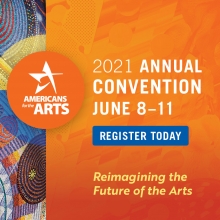Why do the arts matter? If you ask 100 people this question, you will most likely get 100 different answers, but each of these answers will be authentic and personal to that responder. This is what makes the arts so powerful and diverse. There are over 5 million people employed in the creative economy in America. The arts, along with tourism and restaurants, are some of the hardest hit industries as a result of the pandemic. Even after incredible federal, state, and county assistance, 27% of musicians are still unemployed, along with 52% of actors and 55% of dancers. Every county in America, large or small, urban or rural, has the arts as part of its collective experience. Artists live everywhere and their work seeks to engage their fellow humans to ask questions, to look at a topic in a new way, to foster dialogue, or to bring people together. As an arts advocates, it is up to us to recognize and educate others about the value that the arts bring to any county, to encourage it, to highlight it, and even to help support it. The arts will always be there to be part of our nation’s narrative—we just need to listen and to act.
Read More



















